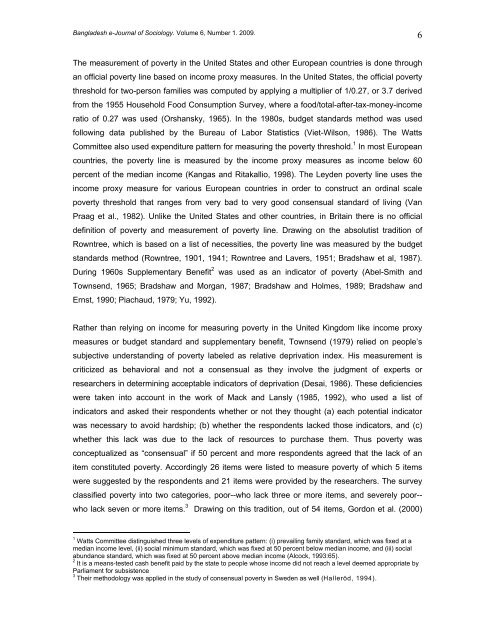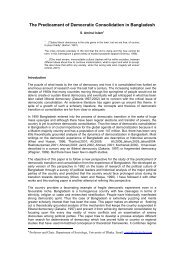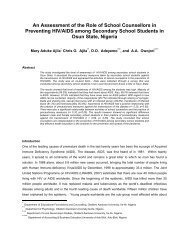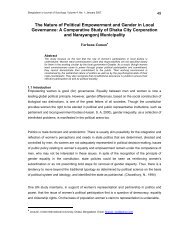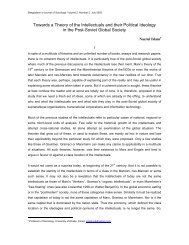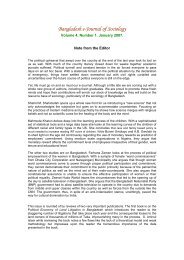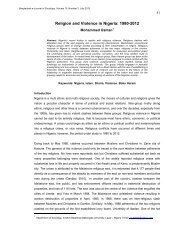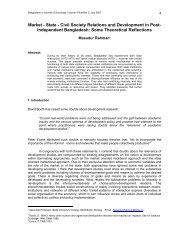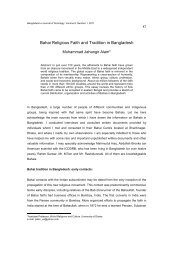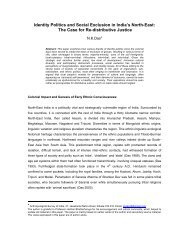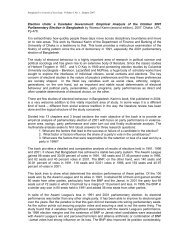Bangladesh e-Journal of Sociology - Bangladeshsociology.org
Bangladesh e-Journal of Sociology - Bangladeshsociology.org
Bangladesh e-Journal of Sociology - Bangladeshsociology.org
Create successful ePaper yourself
Turn your PDF publications into a flip-book with our unique Google optimized e-Paper software.
<strong>Bangladesh</strong> e-<strong>Journal</strong> <strong>of</strong> <strong>Sociology</strong>. Volume 6, Number 1. 2009.<br />
6<br />
The measurement <strong>of</strong> poverty in the United States and other European countries is done through<br />
an <strong>of</strong>ficial poverty line based on income proxy measures. In the United States, the <strong>of</strong>ficial poverty<br />
threshold for two-person families was computed by applying a multiplier <strong>of</strong> 1/0.27, or 3.7 derived<br />
from the 1955 Household Food Consumption Survey, where a food/total-after-tax-money-income<br />
ratio <strong>of</strong> 0.27 was used (Orshansky, 1965). In the 1980s, budget standards method was used<br />
following data published by the Bureau <strong>of</strong> Labor Statistics (Viet-Wilson, 1986). The Watts<br />
Committee also used expenditure pattern for measuring the poverty threshold. 1 In most European<br />
countries, the poverty line is measured by the income proxy measures as income below 60<br />
percent <strong>of</strong> the median income (Kangas and Ritakallio, 1998). The Leyden poverty line uses the<br />
income proxy measure for various European countries in order to construct an ordinal scale<br />
poverty threshold that ranges from very bad to very good consensual standard <strong>of</strong> living (Van<br />
Praag et al., 1982). Unlike the United States and other countries, in Britain there is no <strong>of</strong>ficial<br />
definition <strong>of</strong> poverty and measurement <strong>of</strong> poverty line. Drawing on the absolutist tradition <strong>of</strong><br />
Rowntree, which is based on a list <strong>of</strong> necessities, the poverty line was measured by the budget<br />
standards method (Rowntree, 1901, 1941; Rowntree and Lavers, 1951; Bradshaw et al, 1987).<br />
During 1960s Supplementary Benefit 2 was used as an indicator <strong>of</strong> poverty (Abel-Smith and<br />
Townsend, 1965; Bradshaw and M<strong>org</strong>an, 1987; Bradshaw and Holmes, 1989; Bradshaw and<br />
Ernst, 1990; Piachaud, 1979; Yu, 1992).<br />
Rather than relying on income for measuring poverty in the United Kingdom like income proxy<br />
measures or budget standard and supplementary benefit, Townsend (1979) relied on people’s<br />
subjective understanding <strong>of</strong> poverty labeled as relative deprivation index. His measurement is<br />
criticized as behavioral and not a consensual as they involve the judgment <strong>of</strong> experts or<br />
researchers in determining acceptable indicators <strong>of</strong> deprivation (Desai, 1986). These deficiencies<br />
were taken into account in the work <strong>of</strong> Mack and Lansly (1985, 1992), who used a list <strong>of</strong><br />
indicators and asked their respondents whether or not they thought (a) each potential indicator<br />
was necessary to avoid hardship; (b) whether the respondents lacked those indicators, and (c)<br />
whether this lack was due to the lack <strong>of</strong> resources to purchase them. Thus poverty was<br />
conceptualized as “consensual” if 50 percent and more respondents agreed that the lack <strong>of</strong> an<br />
item constituted poverty. Accordingly 26 items were listed to measure poverty <strong>of</strong> which 5 items<br />
were suggested by the respondents and 21 items were provided by the researchers. The survey<br />
classified poverty into two categories, poor--who lack three or more items, and severely poor--<br />
who lack seven or more items. 3 Drawing on this tradition, out <strong>of</strong> 54 items, Gordon et al. (2000)<br />
1<br />
Watts Committee distinguished three levels <strong>of</strong> expenditure pattern: (i) prevailing family standard, which was fixed at a<br />
median income level, (ii) social minimum standard, which was fixed at 50 percent below median income, and (iii) social<br />
abundance standard, which was fixed at 50 percent above median income (Alcock, 1993:65).<br />
2<br />
It is a means-tested cash benefit paid by the state to people whose income did not reach a level deemed appropriate by<br />
Parliament for subsistence<br />
3<br />
Their methodology was applied in the study <strong>of</strong> consensual poverty in Sweden as well (Halleröd, 1994).


